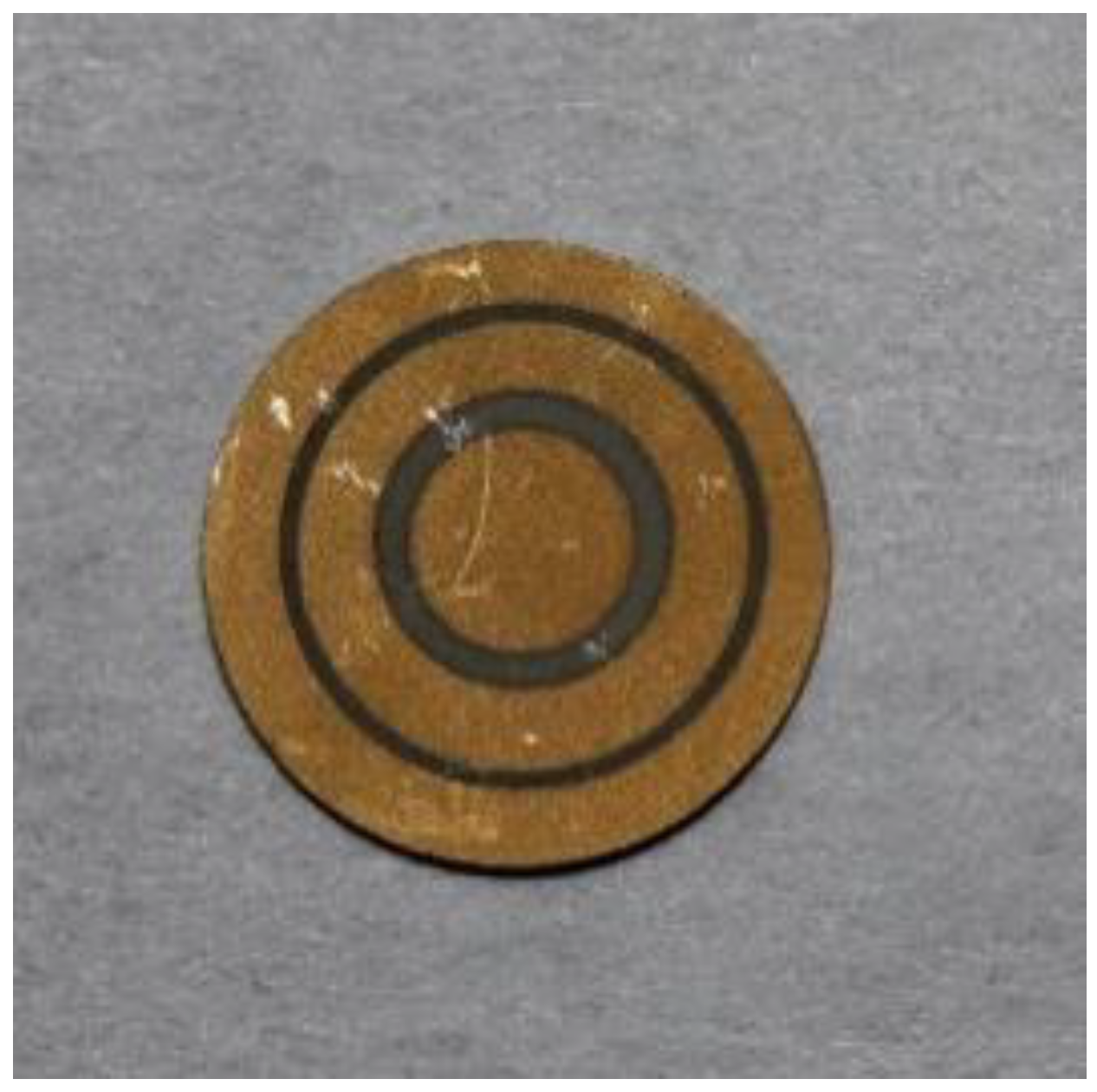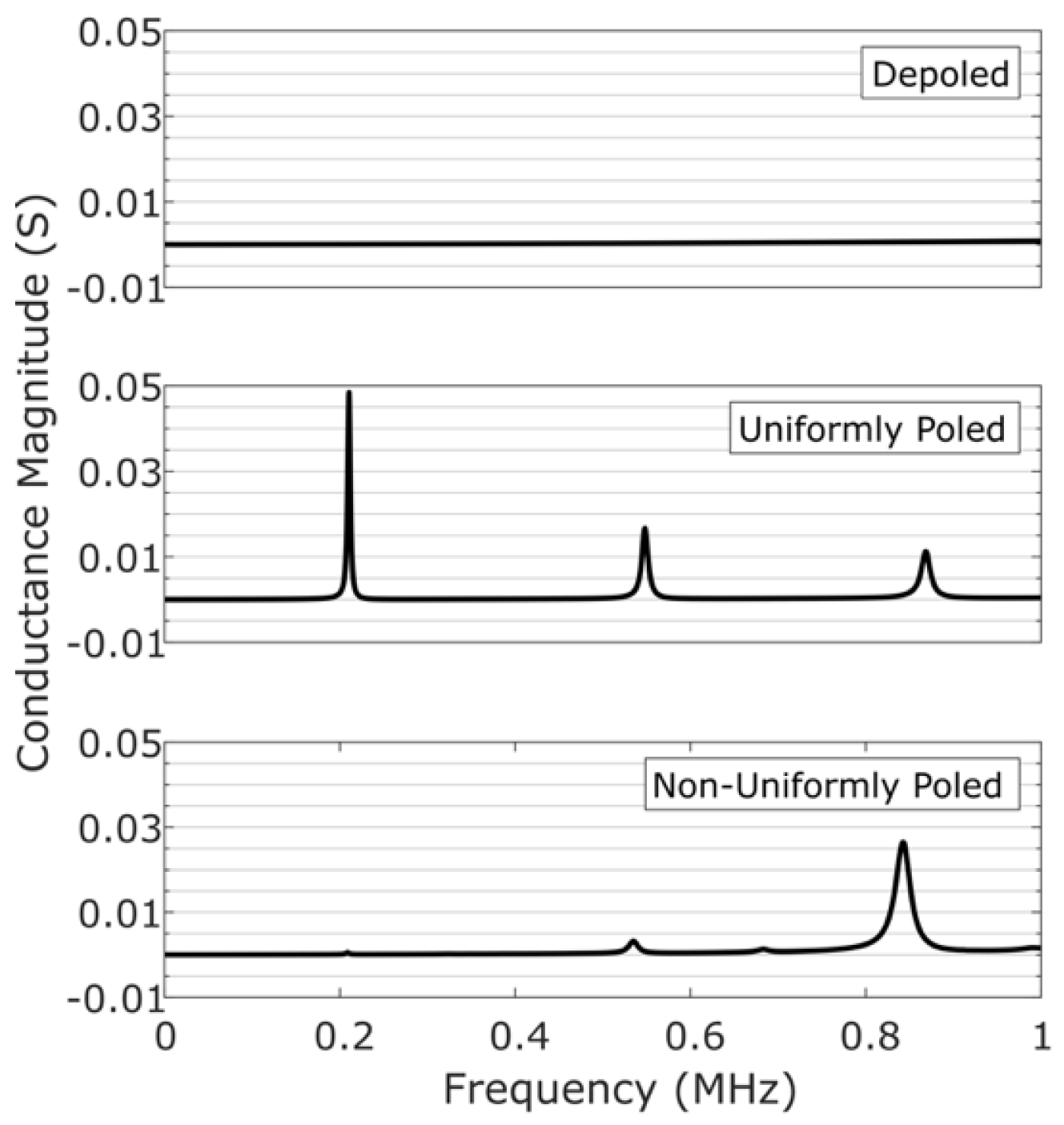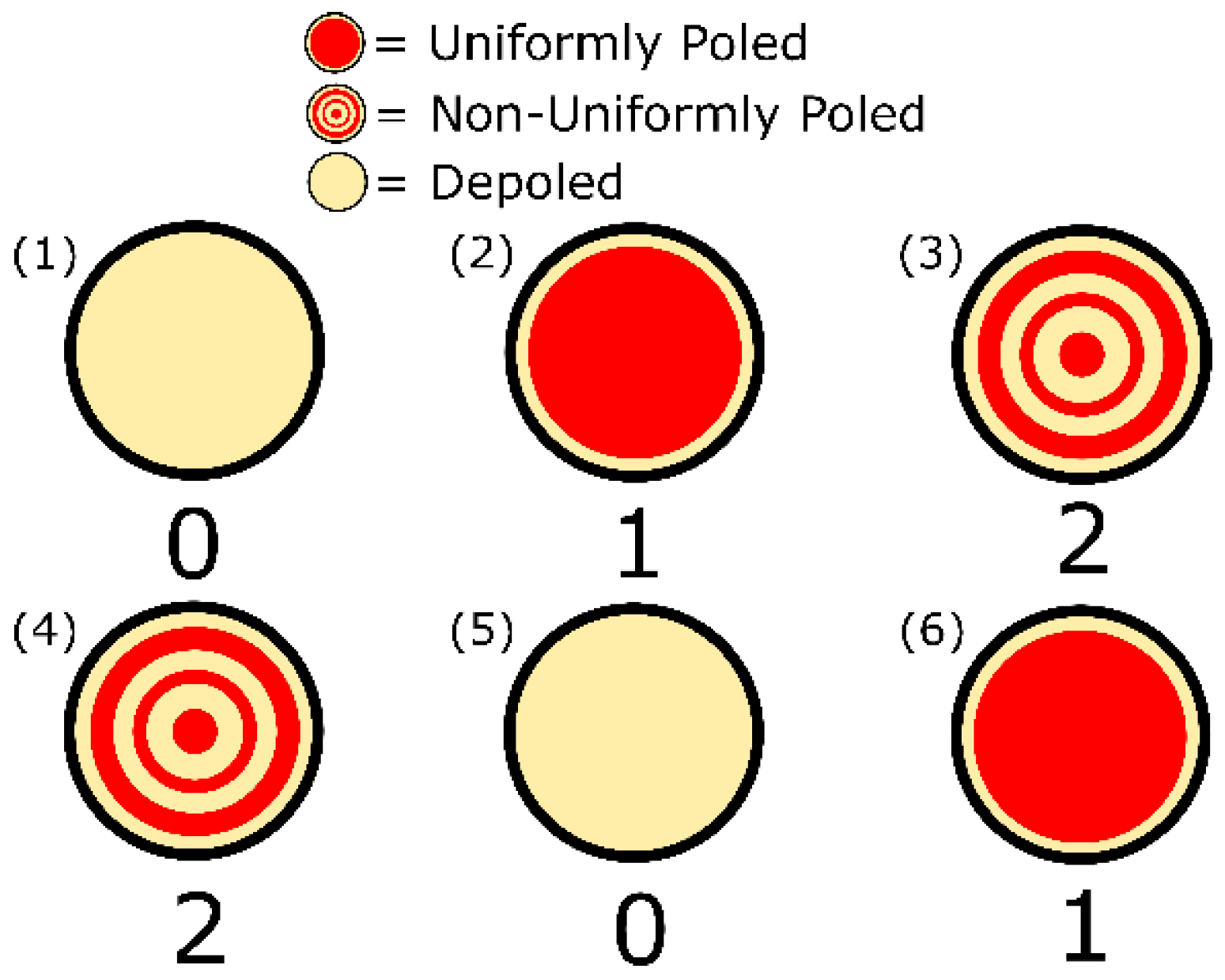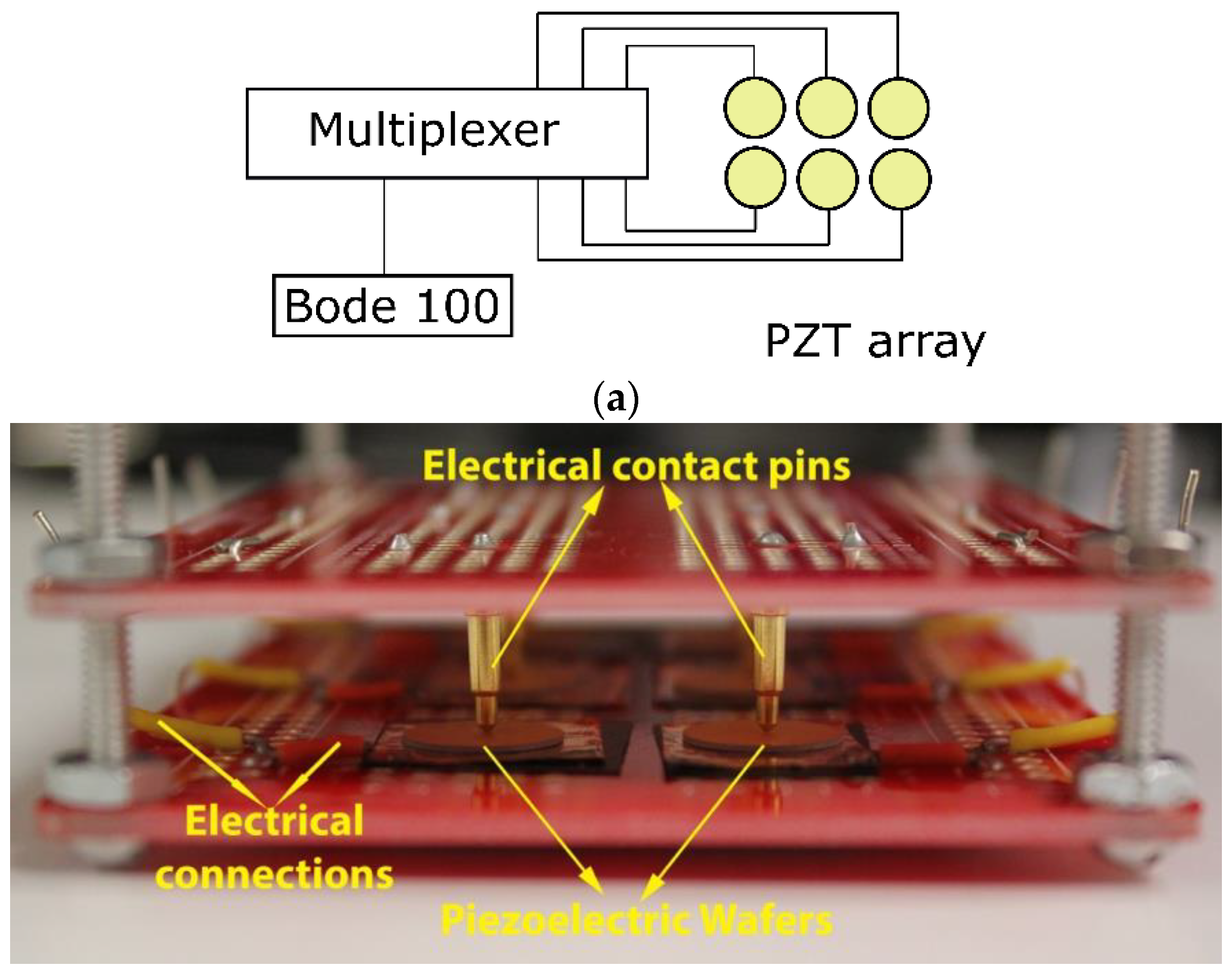Multi-Level Information Storage Using Engineered Electromechanical Resonances of Piezoelectric Wafers: A Concept Piezoelectric Quick Response (PQR) Code
Abstract
1. Introduction
- While traditional methodologies typically use a binary encoding (i.e., a ‘1′ or ‘0′ bit), the frequency-dependent response of a piezoelectric wafer allows for multiple states by utilizing enhanced/suppressed electromechanical resonances. For example, one can achieve ternary encoding with three states ‘0′, ‘1′, and ‘2′.
- The piezoelectric wafers with different information states can be made to look visually identical to each other. Hence, the stored information cannot be decoded using a visual tool such as a camera.
- The methodology does not rely on a line-of-sight access and can also be used in scenarios where piezoelectric wafers can be embedded inside objects or enclosures, thus making it less susceptible to tampering.
2. Multi-Level Information Storage Using Piezoelectric Wafers
- (1)
- Depoled: A piezoelectric wafer that is not polarized. When measured, this does not show any electromechanical resonances.
- (2)
- Uniformly Poled: A uniform polarization throughout the piezoelectric wafer with all the dipoles aligned along the thickness. When measured, a wafer with this polarization profile yields all the electromechanical resonances typically observed for the wafer’s geometry.
- (3)
- Non-Uniformly Poled: A polarization profile that is engineered to enhance a specific resonant mode. When measured, a wafer with this polarization profile yields a stronger resonance at the targeted mode while the surrounding modes are suppressed.
3. Information Retrieval from the PQR Code
- ‘0′ trit: there are no peaks above threshold at the first and third radial modes.
- ‘1′ trit: there is a peak above threshold at the first radial mode, but not at the third radial mode.
- ‘2′ trit: there is a peak above threshold at the third radial mode, but not at the first radial mode.
Author Contributions
Funding
Conflicts of Interest
References
- Denso Wave Incorporated. History of QR Code. Available online: https://www.qrcode.com/en/history/ (accessed on 6 December 2019).
- Denso Wave Incorporated. Types of QR Code. Available online: https://www.qrcode.com/en/codes/ (accessed on 6 December 2019).
- Chawla, V.; Ha, D. An overview of passive RFID. IEEE Commun. Mag. 2007, 45, 11–17. [Google Scholar] [CrossRef]
- Johnston, R. Tamper-Indicating Seals: Practices, Problems, and Standards; Los Alamos National Laboratory: Los Alamos, NM, USA, 2003; No. LA-UR-03-0269.
- Fujitsu. FRAM (Ferroelectric RAM); Fujitsu Limited: Minato City, Tokyo, Japan, 2020; Available online: https://www.fujitsu.com/us/products/devices/semiconductor/memory/fram/ (accessed on 5 February 2020).
- Cypress. F-RAM (Nonvolatile Ferroelectric RAM); Cypress Semiconductor Corp: San Jose, CA, USA, 2020; Available online: https://www.cypress.com/products/f-ram-nonvolatile-ferroelectric-ram (accessed on 5 February 2020).
- Arimoto, Y.; Ishiwara, H. Current Status of Ferroelectric Random-Access Memory. MRS Bull. 2004, 29, 823–828. [Google Scholar] [CrossRef]
- Lee, D.; Yang, S.M.; Kim, T.H.; Jeon, B.C.; Kim, Y.S.; Yoon, J.-G.; Lee, H.N.; Baek, S.H.; Eom, C.B.; Noh, T.W. Multilevel Data Storage Memory Using Deterministic Polarization Control. Adv. Mater. 2012, 24, 402–406. [Google Scholar] [CrossRef] [PubMed]
- Calas, H.; Figueredo, J.; Moreno, E.; Eiras, J.; Leija, L.; Vera, A. A model for radial modes in piezoelectric disk exhibiting Bessell polarizations. Appl. Phys. Lett. 2007, 91, 263509. [Google Scholar] [CrossRef]
- Calas, H.; Moreno, E.; Eiras, J.; Aulet, A.; Figueredo, J.; Leija, L. Non-uniformly polarized piezoelectric modal transducer: Fabrication method and experimental results. Smart Mater. Struct. 2006, 15, 904–908. [Google Scholar] [CrossRef]
- Sawatzky, G.; Huizinga, S. Information storage in piezoelectric powders. Appl. Phys. Lett. 1976, 28, 476–478. [Google Scholar] [CrossRef]
- Kocbach, J. Finite Element Modeling of Ultrasonic Piezoelectric Transducers. Ph.D. Thesis, University of Bergen, Bergen, Norway, 2000. [Google Scholar]
- Chillara, V.; Davis, E.; Pantea, C.; Sinha, D. Ultrasonic Bessel beam generation from radial modes of piezoelectric discs. Ultrasonics 2019, 96, 140–148. [Google Scholar] [CrossRef] [PubMed]
- Calas, H.; Moreno, E.; Eiras, J.; Crespo, Y.; Leija, L.; González, G. Simulation of Bessel beam transducers using impulse response technique. Rev. Mex. De Fis. 2006, 52, 86–88. [Google Scholar]
- Holland, R. Contour extensional resonant properties of rectangular piezoelectric plates. IEEE Trans. Sonics Ultrason. 1968, 15, 97–104. [Google Scholar] [CrossRef]
- Chillara, V.; Hakoda, C.; Pantea, C. On the in-plane vibrations and electromechanical resonance characteristics of non-uniformly polarized rectangular piezoelectric wafers: Selective mode-type excitation and resonance enhancement. J. Sound Vib. 2020. Submitted for publication. [Google Scholar]
- Hakoda, C.; Pantea, C.; Chillara, V. Investigation of resonance enhancement through non-uniform piezoelectric polarization for information storage methodology. In Proceedings of the Active and Passive Smart Structures and Integrated Systems IX, San Francisco, CA, USA, 27 April–8 May 2020. [Google Scholar]





| Ring # | Inner Radius (mm) | Outer Radius (mm) | Polarization Rirection |
|---|---|---|---|
| 1 | 0 | 1.78 | Up |
| 2 | 2.38 | 3.59 | Down |
| 3 | 3.85 | 4.98 | Up |
| Piezoelectric Wafer # | (1) | (2) | (3) | (4) | (5) | (6) |
|---|---|---|---|---|---|---|
| Encoded Data | 0 | 1 | 2 | 2 | 0 | 1 |
Publisher’s Note: MDPI stays neutral with regard to jurisdictional claims in published maps and institutional affiliations. |
© 2020 by the authors. Licensee MDPI, Basel, Switzerland. This article is an open access article distributed under the terms and conditions of the Creative Commons Attribution (CC BY) license (http://creativecommons.org/licenses/by/4.0/).
Share and Cite
Hakoda, C.; Davis, E.S.; Pantea, C.; Chillara, V.K. Multi-Level Information Storage Using Engineered Electromechanical Resonances of Piezoelectric Wafers: A Concept Piezoelectric Quick Response (PQR) Code. Sensors 2020, 20, 6344. https://doi.org/10.3390/s20216344
Hakoda C, Davis ES, Pantea C, Chillara VK. Multi-Level Information Storage Using Engineered Electromechanical Resonances of Piezoelectric Wafers: A Concept Piezoelectric Quick Response (PQR) Code. Sensors. 2020; 20(21):6344. https://doi.org/10.3390/s20216344
Chicago/Turabian StyleHakoda, Christopher, Eric S. Davis, Cristian Pantea, and Vamshi Krishna Chillara. 2020. "Multi-Level Information Storage Using Engineered Electromechanical Resonances of Piezoelectric Wafers: A Concept Piezoelectric Quick Response (PQR) Code" Sensors 20, no. 21: 6344. https://doi.org/10.3390/s20216344
APA StyleHakoda, C., Davis, E. S., Pantea, C., & Chillara, V. K. (2020). Multi-Level Information Storage Using Engineered Electromechanical Resonances of Piezoelectric Wafers: A Concept Piezoelectric Quick Response (PQR) Code. Sensors, 20(21), 6344. https://doi.org/10.3390/s20216344






